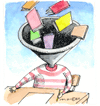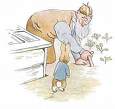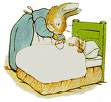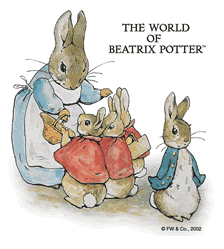English 2F - Children's Literature
Module 3: Analyzing Children's Lit: Picture Books
Literature, in both oral and written form, is a fantastically effective medium for transmitting culture. The child's social circle, especially the immediate family, is the main influence, but I would argue that literature is (or can be) an important element of the child's social world. |
 |
Certainly, for some children, the characters in stories are as real, if not more so, than the people in "real life". |
Children's Literature as Ideology Children's literature has always been used to pass values from one generation to the next. The books reflect the values of the dominant culture, and send messages, subtle and overt, about those values. |
||||||||
|
||||||||
Consider the other, more subtle messages, however. What do you make of the fact that Peter's father was killed by Mr. McGregor and Peter, the only boy, seems compelled to run into McGregor's garden? What do the pictures and text suggest about motherhood and fatherhood, and masculinity and feminity? Once you begin asking yourself these kinds of questions, you are on the road to deep analysis. |
||||||||
|
What does the illustration at left suggest about gender roles, gender expectations, and about the nature of girlhood and boyhood? |
And what about the fact that, in the end, Peter isn't really punished at all, except for having had a bit of a fright and some chamomile tea at bedtime? |
Peter's so-called "punishments" might be rewards in disguise. In the end, he's had a grand adventure and the greatest comfort of all, at least according to Western culture - the love of a nurturing mother. The memory of the lost father, the dangers of the garden, and perhaps the lesson of the entire adventure, fade into oblivion. We are not at all sure that he won't do it again. |
In fact, I've always assumed Peter ended up as a pie himself someday. It's inevitable. Boys will be boys, and look at what happened to his father, after all..... |
|
In Module 3, we will begin to look at children's literature with an eye for analysis. We'll begin with picture books. Most folks assume that picture books are the easiest genre to analyze, since they are written for the youngest children, and because the text (particularly the vocabulary) are relatively simple. However, you'll soon find that picture books are among the most complicated to analyze, since you're analyzing not only the text and the subtle cultural messages therein, but also the illustration, which contain messages of their own that children can (and do) recognize and interpret. Additionally, because they are for the youngest readers, picture books have a proportionally greater influence than other books. Children often read and look at picture books with parents, older siblings, relatives or friends, even peers, and so it becomes a social activity as well as intellectual, creative and emotional. It can even be a physical activity, as the children sit with their compadres to read, look at the pictures and discuss. The ideas represented in the book are therefore even more effectively transmitted to the young child, who is just beginning to understand how the world works, and relies on those early mediators to get an accurate view of how things are. |
|
| Read the web resources below for tips on analyzing picture books, and for lists of picture books to choose from for Essay 1. | |
Tips for Analyzing Picture Books
Sample Questions for Picture Book analysis - UNM
Picture Book Image Analysis - Dr. Frank Serafini
Notes for the Analysis of Picture Books
Bibliographies of Picture Books
100 Picture Books Everyone Should Know
Ezra Jack Keats 10 Recommended Sites for Multicultural Books
Fifty Multicultural Books Every Child Should Know

 ... first when Mr. McGregor hunts him
... first when Mr. McGregor hunts him ...and then at home, when he is put to bed without any supper.
...and then at home, when he is put to bed without any supper.